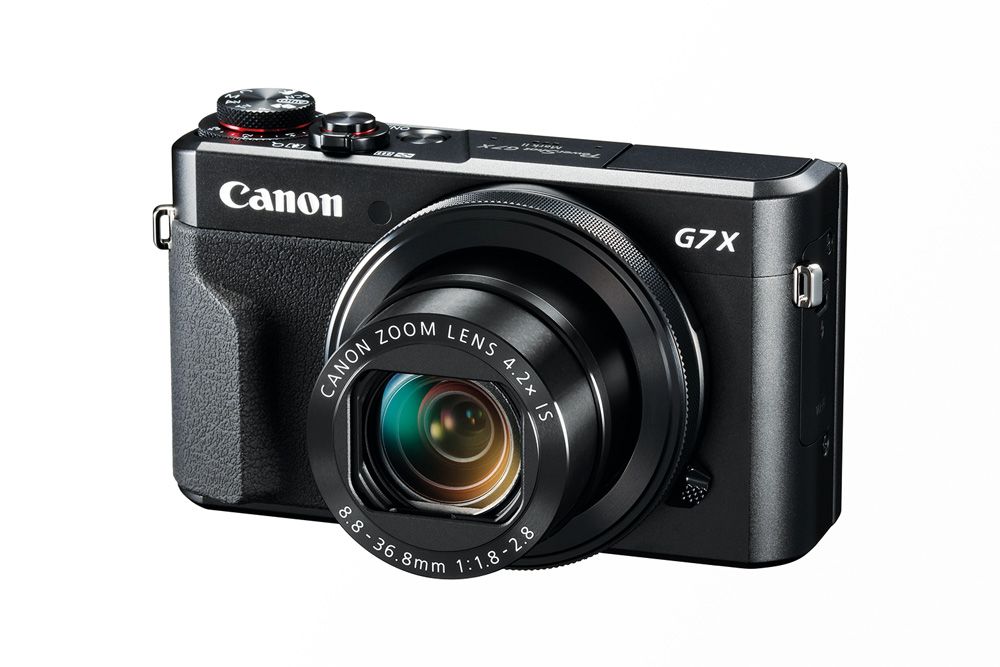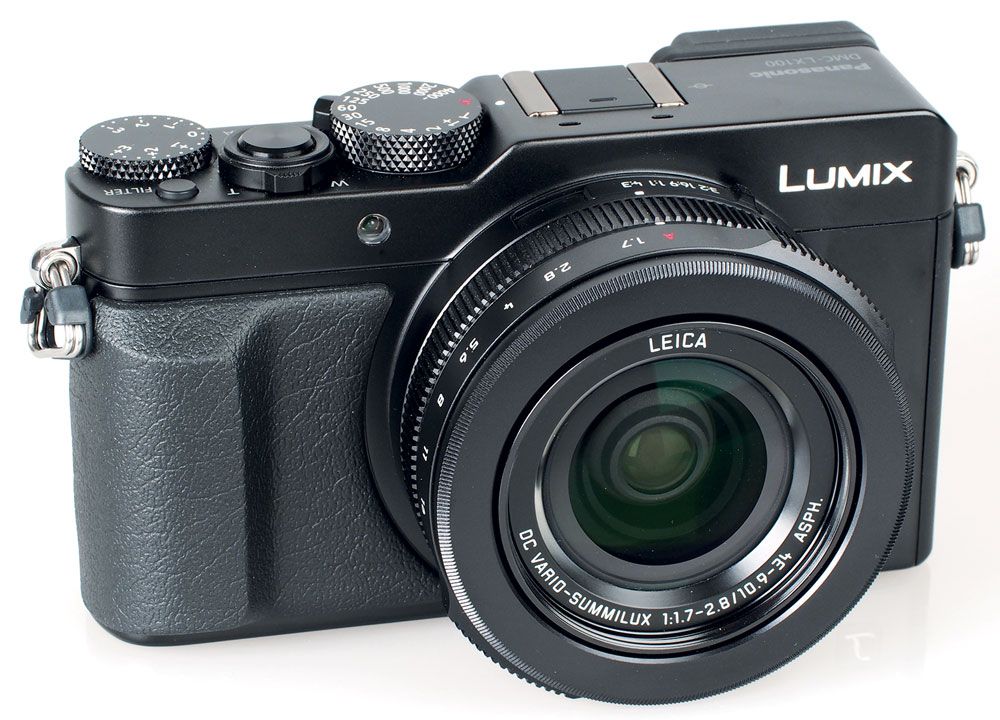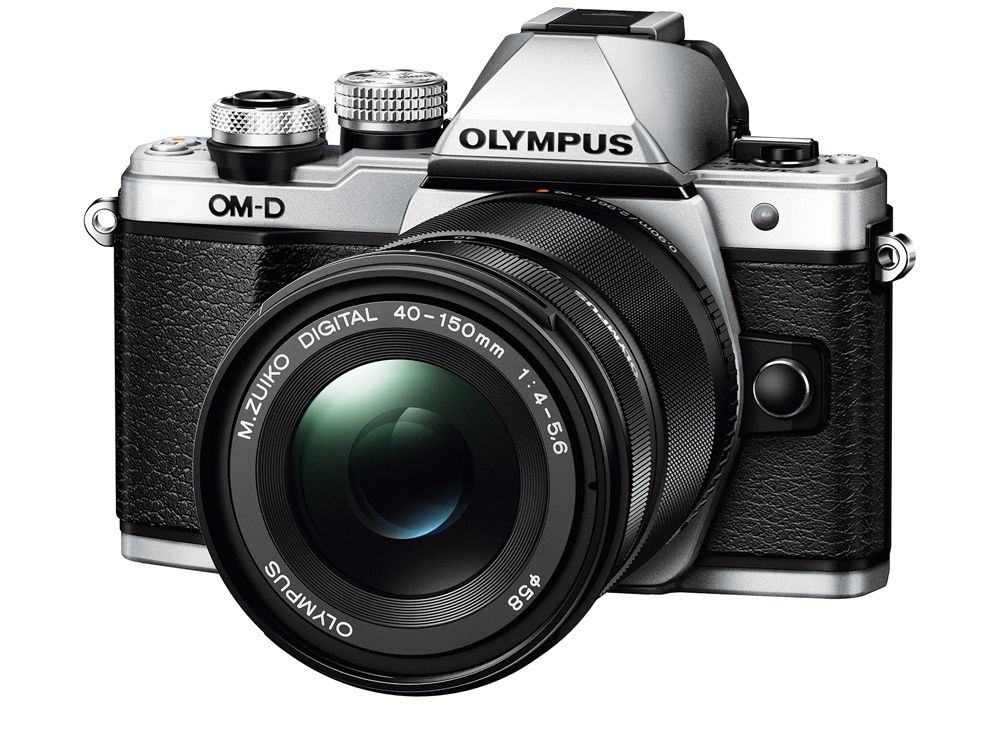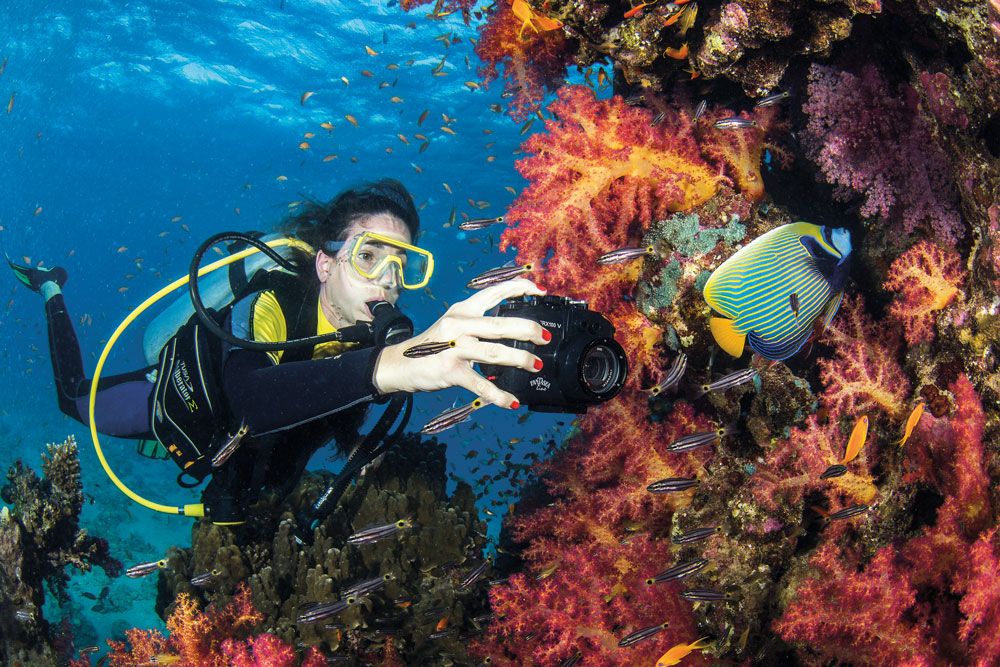
Mark ‘Crowley’ Russell cuts through the jargon and gets the full picture with a round-up of some of the best compact and mirrorless cameras for underwater photography

Some compact cameras have a proprietary housing for underwater use. There is also a range of housings available from different manufacturers, with various features that are reflected in the price. This may include the ability to connect an external strobe directly to the camera’s body through waterproofed connectors (rather than using the fibre optic system triggered by the camera’s own flash), or the possibility of adding extra ‘wet’ lenses to increase the range of functionality with respect to macro or wide-angle photography.
DIVE CHOICE: Best-Value Compact
Canon Powershot G7X MkII

Camera £552.99 • Housings: Canon (40m) £244.99; Fantasea (60m) £495; Nauticam (100m) £1,017
Canon’s Powershot series has been evolving from its launch in 1996 and is one of the best-selling digital camera series of all time. The G7X MkII is an updated version of the popular G7X, retaining the 1.0”, 20MP sensor but adding a faster processor for better focusing speed, and higher image quality, with a new front control ring allowing for the manipulation of settings without entering the menu system. The camera comes highly rated for underwater photography and has an excellent electronic macro mode, although setting the white balance is a fiddly process involving multiple menu clicks. A reasonably priced underwater housing is available from Canon, Fantasea makes an alternative rated to 60m, and Nauticam a specialist housing rated to 100m which allows the use of optional underwater lenses.
Specifications
Sensor 1.0”, 20.1MP (Max res: 5472 x 3648)
Zoom 4.2 x optical, 8.4 x digital
Manual White Balance Yes
Full Manual Yes
RAW Yes
Macro Mode Yes
Video 1920 x 1080, full HD
DIVE CHOICE: Best-Overall Compact
Sony Cybershot RX100V

RX100V £1,000; RX100III £799. Housing: Sony (40m) £320; Fantasea (60m) £495; Nauticam (100m) wet lenses £1,159.99
Sony’s flagship RX100 compact series comes highly rated by both enthusiastic amateurs and professionals alike. The original model was among the first compact camerasto feature a large, 20MP 1.0” sensor, in one of the most compact designs on the market. Currently, in its fifth generation, the camera has not changed a great deal in appearance since the original, with most of the upgrades applied to the internal electronics, including an impressive continuous ‘burst’ shooting speed of 24 frames per second (fps). The RX100III and IV are still widely available, and although some of the features might have changed, the small and compact body of the camera has not, meaning that some of the available housings are compatible with all three versions of the camera.
Specifications
Sensor 1.0”, 20.1 MP Max res: 5472 x 3648)
Zoom 5.8 x optical, 11 x digital
Manual White Balance Yes
Full Manual Yes
RAW Yes
Macro Mode yes
Video 3840 x 2160 4K
Panasonic DMC-LX100

DMC-LX100 £599, Housing: Nauticam: £1,109; Ikelite £850
The LX100 is a compact camera with a 4/3” sensor more commonly found in mirrorless systems. Adding to the extra level of creative control are a manually operated focus ring and aperture rings that are more common to the non-retractable lenses of higher-specification cameras and which allow you to experiment on the fly, rather than having to fiddle about with extra buttons and menu settings. It is a little chunkier than some of the other manufacturers’ equivalents, and this is reflected in the housing design, which must accommodate a lens with a much longer reach than other cameras. The LX100 has no inbuilt flash, which means that external strobes cannot be fired by the fibre-optic adapters but must be connected via external connections to the camera’s ‘hot shoe’, where external flash accessories would be mounted for surface use.
Specifications
Sensor 4/3”, 12.8 MP (Max res: 4112 x 3088)
Zoom 3.1 x optical, 4 x digital
Manual White Balance Yes
Full Manual Yes
RAW Yes
Macro Mode Yes
Video 3840 x 2160 4K
SeaLife DC2000

RRP (camera + housing): £669
The recently launched DC2000 has brought SeaLife’s range up to date and in line with its competitors. One of the only manufacturers to produce dedicated underwater cameras – rather than cameras which can be taken underwater – the DC2000 comes with a rubber, shockproof housing as standard, rated for use to 60m. The inner camera can be removed for more convenient use out of the water and is by itself rated to 18m. Three standard sets of strobe and lighting expansions are available with SeaLife’s own equipment, allowing for a complete underwater system to be assembled straight out of the box with a minimum of fuss.
Specifications
Sensor 1/2.3”, 20 MP (Max res: 5472 x3648)
Zoom 1 x optical, 3 x digital
Manual White Balance Yes
Full Manual Yes
RAW Yes
Macro Mode Yes
Video 1920 x 1080p, full HD

Mirrorless cameras have interchangeable lenses and most are sold ‘body only’, allowing the photographer to select the lenses that will suit them best. Some of the cameras featured here are sold with basic ‘kit lenses’ which give a wide range of functionality, but without maximising the potential of the camera for more specialist types of photography, such as macro.
All the cameras are manually adjustable and, since the full list of specifications for each camera and its range of available lenses cannot be easily summarised, we’ve highlighted just the sensor ratings and maximum resolution for photo and video. The listed prices for the housings are for the body only, as the port required for the front of the camera will vary in size and price according to the type of lens fitted to the camera. You can expect to pay an additional £200–£300 (or more, depending on the housing) for the port. Check with the retailer for more details.
DIVE CHOICE: Best-Value Mirrorless
Olympus OM-D EM-10 Mark II

Body and 14-42mm lens: £499.99. Housing: Ikelite £1,045; Nauticam £1,340
One of the most popular brands of mirrorless, interchangeable lens cameras, the EM-10 Mark II is an upgrade from its EM-10 predecessor, and incorporates some of the better features of the top-of-the-range EM-5 Mark II, such as the image stabilisation, uprated viewfinder, and the introduction of an electronic shutter rather than the traditional mechanical version to improve the speed of autofocus (particularly helpful in the low-light conditions found underwater). Retaining the 16MP 4/3” sensor of the previous camera has helped to reduce overall cost without upgrading the pixel count unnecessarily, and the inclusion of a standard 14-42mm lens with the camera means that the beginner doesn’t need to invest in separate lens from the get-go, further helping to keep down costs. A wide range of the highly-rated Zuiko lenses are available for the more advanced enthusiast. It is worth noting that the top-of-the-range EM-5 Mark II, although more expensive at £899 for the body only, does have a proprietary housing from Olympus with a RRP of £799.
Specifications
Sensor 4/3”, 16.1 MP (Max res: 4608 x 3456)
Video 1920 x 1080, full HD
Canon EOS-M3

Camera (body + 15-45mm lens): £489.99; Housing (without port) £1,045 (Ikelite); £1,340 (Nauticam)
Although Canon has been one of the leaders in compact digital cameras, it was one of the last to commit to the mirrorless market. The EOS-M3 is targeted at the entry-level enthusiast and comes at a very reasonable price, packaged with a standard lens, although there is a limited range of alternatives. With its 24 MP 4/3” sensor it is capable of producing high-quality images, but unlike the company’s compact cameras – for which Canon has one of the widest range of proprietary underwater housings – there is no underwater housing available from Canon for any of its EM range. Designs from other manufacturers are limited, which to some extent negates the inexpensive price of the camera. The EOS-M3 has been superseded by newer models, but underwater housings are not currently available.
Specifications
Sensor 4/3”, 24.2 MP (Max res: 6000 x 4000)
Video 1920 x 1080, full HD
DIVE CHOICE: Best-Overall Mirrorless
Sony Alpha 6500 / 6300

Camera body only: £1,500 (6500); £1,159 (6300). Housings without ports for the 6500: Nauticam £1,664; Ikelite £999; Fantasea £1,100
The Alpha 6500 (also listed as the a6500) is the latest in Sony’s 6000-series of mirrorless cameras, promoted by the manufacturer as having the fastest autofocus system in the category, as was its predecessor the 6300. While retaining much of the 6300’s specifications, the updated version comes with extra image stabilisers, a faster processor enabling – among other things – an increase in burst shooting capability, and a touch-screen display. The camera body does not come packaged with a standard lens, hence a separate purchase is necessary which will increase the overall cost somewhat, with the a6500’s retail price already almost £400 higher than the a6300. Experienced enthusiasts may wish to shell out more for the latest model but relative novices could go for the a6300.
Specifications
Sensor 4/3”, 24.2 MP (Max res: 6000 x 4000)
Video 3840 x 2160 4K
Panasonic Lumix GX85/GX80

£569.99 with 12-32mm kit lens. Housing without port: Nauticam £1,334; Ikelite £1110
The GX85 and GX80 are the same camera – the former being the US model number and the latter for everywhere else, except in Japan, where it’s the GX7MkII. Although the product naming may be slightly confusing, the GX80 is a solidly built, small camera which excels at 4K video production. The low-light and white-balance handling have been highly rated, always very useful for underwater photography and filming. Although the body can be bought separately, it is available with a standard 12-32mm kit lens at a very reasonable price, making it an excellent option for the first-time buyer, with Panasonic’s broad range of additional lenses available for the more advanced photographer.
Specifications
Sensor 4/3”, 16 MP (Max res: 6000 x 4000)
Video 3840 x 2160 4K
Buying tips

As a general rule of thumb, buy the best that you can afford based on your personal requirements and budget. If you just want to take happy holiday snaps, then pretty much anything will do, including fully automated point-and-shoot models, smartphones and action cameras. As long as there is a housing available that will protect it at depth, you’ll get some reasonably good shots.
Beyond that, the fundamental principles of photography remain the same, whether you buy a camera from the bottom end of the market or nearer the top. As long as the camera allows you full manual control of settings such as white balance, ISO, aperture size and shutter speed, you’ll be able to experiment and learn how each affects your underwater pictures. Most will have a fully automatic mode if you don’t have time to stop and make adjustments. You may also wish to consider luggage space for travelling with an underwater camera, and don’t forget to take into account the size of the housing. If you plan to travel a lot during a trip then the smaller compact may be a better option than lugging around a system that requires its own backpack.
When it comes to price, a new camera and housing will not come cheaply. You can pick up a high-quality compact camera and housing for under £1,000, but for some mirrorless cameras, that won’t even cover the cost of the housing. Older models of camera are still available and will come at a lower price, and don’t forget that some of these would have been classed as top-of-the-range when new, though housings may be more difficult to come by.
Needless to say, the internet is full of second-hand cameras. The usual caveats apply, and look for dedicated camera suppliers who will be able to offer a guarantee for their product. Be especially careful with second-hand housings – if a camera breaks it may be refundable, but if a housing fails underwater then you will lose the camera as well. Speak directly to housing manufacturers to see if they have refurbished, guaranteed, second-hand equipment available.
Finally – talk to an expert. Specialist underwater retailers such as Cameras Underwater in the UK, or distributors for bespoke housing manufacturers will offer expert advice and be happy to help.
Jargon Busting

Megapixels
This is often used as a selling point, but don’t be sold on megapixels (MP) alone. Pixels are the smallest picture element (hence the name) that can be individually manipulated. One MP is one million (1,048,576, for the pedants) pixels and therefore a 20MP camera will produce a picture that is comprised of 20 million individual dots. The number of MPs affects the overall size of the picture, in terms of both the picture’s dimensions and computer file size. But 10MP is more than enough to print a photo-quality image on an A3-sized piece of paper (that’s larger than a double-page spread in this magazine). If in that image there was one small area that you wanted to zoom into and create a new image then the maximum size the new image can be reproduced at is dependent on the number of the camera’s megapixels. The larger the original file, the bigger the new image can be without losing print quality.
Sensors
Sensors are more important than megapixels. The size of the camera’s sensor determines how much light it can capture, and the more light a device can capture the better. A high megapixel rating is rendered meaningless without a large sensor. For compact cameras, there are three main sensor ratings, usually described in terms of inches (from highest to lowest): 1”, 1/1.7” and 1/2.3”. You’ll still get great photos from cameras with the smaller sensor but bigger, at least in this case, is better. Most mirrorless cameras have larger sensors rated at 4/3”.
White balance
Being able to manually control white balance is one of the most important features of a camera that is used underwater. Light is made up of a spectrum of different colours, with each wavelength being absorbed at a different rate. This is why everything looks blue underwater, as it is the last colour in the spectrum to be absorbed. White balance allows you to ‘tell’ the camera that what it’s looking at any given depth is white (a blank slate, for example), and it will use that information to remove the unwanted blue tinge from everything else.
RAW
All graphic file formats – such as JPG, PNG, GIF and so on – remove some information from the picture in order to reduce the size of the file. For a lot of pictures this makes very little visible difference. But some information is removed during the process, reducing the effectiveness of image processing software such as Photoshop. RAW images retain all the information that was captured by the camera’s image sensor and therefore allow for the maximum range of manipulation in image processing software. Practically speaking, the JPEGs produced by most cameras are more than adequate and hence shooting in RAW is not essential for producing high-quality images, but it’s useful for those more skilled in image manipulation. Most high-end cameras have an option to shoot in RAW, and many have the option to shoot RAW and JPG simultaneously.
Strobes
Strobes are adjustable lighting arrays that can angle the flash so that it doesn’t reflect directly back into the camera lens, thus reducing backscatter and allowing for more creative shots. There are universal strobes available which will screw into a standard thread on the camera housing, activating the strobe through a fibre-optic cable covering the flash from the camera. These are relatively inexpensive and are suited to the amateur photographer. More advanced cameras, housings and strobes, connect directly to the camera body through waterproofed connectors, allowing you to fire them independently of the shutter and control the strobe’s brightness and timing. These are more expensive.
ISO
ISO determines how sensitive the camera’s image sensor is to light. In general, low ISO is used in well-lit environments and high ISO in darker ones. ISO 100 is a general default setting, and although the range can be as low as 50 or as high as 204,800 in top of the range DSLRs, the ‘normal’ useable range in digital cameras is between 200 and 3200.


